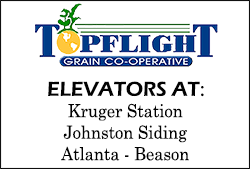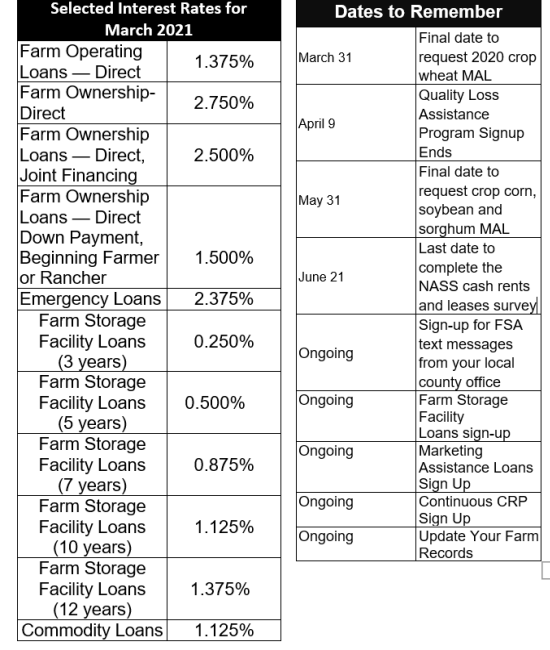|
 Farmers and ranchers working with USDA’s Farm Service Agency can
now sign and share documents online in just a few clicks. By
using Box or OneSpan, producers can digitally complete business
transactions without leaving their homes or agricultural
operations. Both services are free, secure, and available for
multiple FSA programs. If you are interested in utilizing these
new tools, please contact your local Service Center. Farmers and ranchers working with USDA’s Farm Service Agency can
now sign and share documents online in just a few clicks. By
using Box or OneSpan, producers can digitally complete business
transactions without leaving their homes or agricultural
operations. Both services are free, secure, and available for
multiple FSA programs. If you are interested in utilizing these
new tools, please contact your local Service Center.
Before the calendar turns to planting season, please take some
time to update your farm records. FSA is cleaning up our
producer record database and needs your help. Please telephone
or email your local Farm Service Agency and report any of the
following:
• change of address, zip code, phone number, email address
• an incorrect name or business name on file

• changes in your farm operation, like the addition of a farm
by a lease or purchase
• changes to your operation in which you reorganize to form
a Trust, LLC or other legal entity
Updating these changes now will be beneficial for program
integrity moving forward.
If you are considering additional on-farm storage for this
year’s crop, please consider FSA’s Farm Storage Facility Loan
Program (FSFL). The FSFL program provides low-interest financing
to help you build or upgrade storage facilities and to purchase
portable (new or used) structures, equipment and storage and
handling trucks.
I’m hoping everyone has a safe spring planting season, and
please remember to report your acres to your local FSA office
after you are finished planting!
Stay safe and healthy!
Dan Puccetti
Acting State Executive Director
FSA Offers Joint Financing Option on Direct
Farm Ownership Loans
The USDA Farm Service Agency’s (FSA) can help farmers and
ranchers become owner-operators of family farms, improve and
expand current operations, increase agricultural productivity,
and assist with land tenure to save farmland for future
generations.
There are three types of Direct Farm Ownership Loans: regular,
down payment and joint financing. FSA also offers an option for
smaller financial needs up to $50,000.
Joint financing allows FSA to provide more farmers and ranchers
with access to capital. FSA lends up to 50 percent of the total
amount financed. A commercial lender, a State program or the
seller of the property being purchased, provides the balance of
loan funds, with or without an FSA guarantee. The maximum loan
amount for a joint financing loan is $600,000, and the repayment
period for the loan is up to 40 years.
The operation must be an eligible farm enterprise. Farm
Ownership loan funds cannot be used to finance nonfarm
enterprises and all applicants must be able to meet general
eligibility requirements. Loan applicants are also required to
have participated in the business operations of a farm or ranch
for at least three years out of the 10 years prior to the date
the application is submitted. The applicant must show
documentation that their participation in the business operation
of the farm or ranch was not solely as a laborer.
For more information about farm loans, contact your local County
USDA Service Center for information.

USDA Extends General Signup for Conservation
Reserve Program
The USDA is extending the Conservation Reserve Program (CRP)
General Signup period, which had previously been announced as
ending on February 12, 2021. USDA will continue to accept offers
as it takes this opportunity for the incoming Administration to
evaluate ways to increase enrollment. Under the previous
Administration, incentives and rental payment rates were reduced
resulting in an enrollment shortfall of over 4 million acres.
The program, administered by USDA’s Farm Service Agency (FSA),
provides annual rental payments for 10 to 15 years for land
devoted to conservation purposes, as well as other types of
payments. Before the General CRP Signup period ends, producers
will have the opportunity to adjust or resubmit their offers to
take advantage of planned improvements to the program.
This signup for CRP gives producers an opportunity to enroll
land for the first time or re-enroll land under existing
contracts that will be expiring September 30, 2021. All
interested producers, including those on Indian reservations and
with trust lands, are encouraged to contact their local USDA
Service Center for more information.
Noninsured Crop Coverage Helps Producers
Manage Risks
The Farm Service Agency’s (FSA) Noninsured Crop Disaster
Assistance Program (NAP) helps you manage risk through coverage
for both crop losses and crop planting that was prevented due to
natural disasters. The eligible or “noninsured” crops include
agricultural commodities not covered by federal crop insurance.
You must be enrolled in the program and have purchased coverage
for the eligible crop in the crop year in which the loss
incurred to receive program benefits following a qualifying
natural disaster.
NAP Buy-Up Coverage Option
NAP offers higher levels of coverage, from 50 to 65 percent of
expected production in 5 percent increments, at 100 percent of
the average market price. Buy-up levels of NAP coverage are
available if the producer can show at least one year of
previously successfully growing the crop for which coverage is
being requested.
Producers of organics and crops marketed directly to consumers
also may exercise the “buy-up” option to obtain NAP coverage of
100 percent of the average market price at the coverage levels
of between 50 and 65 percent of expected production.
NAP basic coverage is available at 55 percent of the average
market price for crop losses that exceed 50 percent of expected
production.
Buy-up coverage is not available for crops intended for grazing.
NAP Service Fees
For all coverage levels, the NAP service fee is the lesser of
$325 per crop or $825 per producer per county, not to exceed a
total of $1,950 for a producer with farming interests in
multiple counties.
NAP Enhancements for Qualified Military Veterans
Qualified veteran farmers or ranchers are eligible for a service
fee waiver and premium reduction, if the NAP applicant meets
certain eligibility criteria.
Beginning, limited resource and targeted underserved farmers or
ranchers remain eligible for a waiver of NAP service fees and
premium reduction when they file form CCC-860, “Socially
Disadvantaged, Limited Resource and Beginning Farmer or Rancher
Certification.”
For NAP application, eligibility and related program
information, contact your local County USDA Service Center or
visit http://offices.usda.gov.
Successful Conservation Cropping Seminars
for 2021
This year’s virtual Conservation Cropping Seminars were a
roaring success. Although the in-person events couldn’t be held,
virtual meetings were developed and based on survey feedback,
attendance was very good. This was the 8th year for holding the
event and estimates are that 724 people attended all three
seminars. Keynote speakers included Dr. Nic Jelinski from
University of Minnesota, Ray Archuleta, and Dr. Joel Gruver from
Western Illinois University.
Most registrants were from the US and Illinois, but a surprising
number of participants joined in from other states and there
were several visitors from other countries—something which
doesn’t happen often at regular seminars.
Primary topics include cover crops, soil health, nutrient
management, conservation tillage, and benefits of using
conservation systems. Personal testimonials and stories from
Illinois farmers are always part of the seminars so farmers can
hear from professionals, researchers, and real-life farmers. 41%
of survey respondents indicated they planned to use more soil
health related practices and management activities on their
operations in the future.
What conservation partners are involved in the Conservation
Cropping Seminars? Just a few: Illinois Department of
Agriculture, USDA’s Natural Resources Conservation Service,
American Farmland Trust, the Illinois Stewardship Alliance,
Illinois Environmental Protection Agency, University of Illinois
Extension, and local Soil and Water Conservation Districts.
If you were unable to participate in the LIVE events, you can
still benefit from hearing the speakers and presentations on
your next rainy day. Just visit https://www.youtube.com/playlist?list=PLIq7XlTOe3ali-tWzx08L1C_dMW3eMeAM..
Plans will be underway soon for the 2022 seminars!
USDA Extends Flexibilities Amid Continuing
COVID-19 Pandemic
USDA’s Risk Management Agency is extending crop insurance
flexibilities for you amid the COVID-19 pandemic. Specifically,
relief provided for electronic notifications and signatures is
extended through July 15, 2021; organic certification, replant
self-certification and assignment of indemnity are extended
through June 30, 2021.
RMA is also allowing Approved Insurance Providers (AIPs) further
flexibilities for production reporting, submitting written
agreement requests and obtaining producer signatures for written
agreement offers. Producer signatures for written agreement
offers, issued by RMA on or before June 30, 2021, with an
expiration date on or before July 30, 2021, will allow producer
signatures to be accepted after the expiration date with proper
self-certification or documentation. However, all documentation
and signatures for these offers must be completed no later than
August 2, 2021. AIPs also have 30 business days to submit
written agreement requests and applicable documentation for
requests with submission deadlines prior to July 1, 2021.
For more information about these and other flexibilities, please
refer to Manager’s Bulletin MGR 20-030, RMA’s Frequently Asked
Questions, contact your crop insurance agent or visit
farmers.gov/coronavirus.
USDA Fruit, Vegetable and Wild Rice Planting
Rules Unchanged in 2018 Farm Bill
Fruit, vegetable and wild rice producers will continue to follow
the same rules for certain Farm Service Agency (FSA) programs.
If you intend to participate in the Agriculture Risk Coverage
(ARC) or Price Loss Coverage (PLC) programs, you are subject to
an acre-for-acre payment reduction when fruits and nuts,
vegetables or wild rice are planted on payment acres of a farm.
Payment reductions do not apply to mung beans, dry peas, lentils
or chickpeas. Planting fruits, vegetables or wild rice on acres
not considered payment acres will not result in a payment
reduction. Farms that are eligible to participate in ARC/PLC but
are not enrolled for a particular year may plant unlimited
fruits, vegetables and wild rice for that year but will not
receive ARC/PLC payments. Eligibility for succeeding years is
not affected.
Planting and harvesting fruits, vegetables and wild rice on
ARC/PLC acreage is subject to the acre-for-acre payment
reduction when those crops are planted on more than 15 percent
of the base acres of an ARC enrolled farm using the county
coverage or PLC, or more than 35 percent of the base acres of an
ARC enrolled farm using the individual coverage.
Fruits, vegetables and wild rice that are planted in a
double-cropping practice will not cause a payment reduction if
the farm is in a double-cropping region as designated by the
USDA’s Commodity Credit Corporation.
Fruit, vegetable and wild rice producers will continue to follow
the same rules for certain Farm Service Agency (FSA) programs.
If you intend to participate in the Agriculture Risk Coverage
(ARC) or Price Loss Coverage (PLC) programs, you are subject to
an acre-for-acre payment reduction when fruits and nuts,
vegetables or wild rice are planted on payment acres of a farm.
Payment reductions do not apply to mung beans, dry peas, lentils
or chickpeas. Planting fruits, vegetables or wild rice on acres
not considered payment acres will not result in a payment
reduction. Farms that are eligible to participate in ARC/PLC but
are not enrolled for a particular year may plant unlimited
fruits, vegetables and wild rice for that year but will not
receive ARC/PLC payments. Eligibility for succeeding years is
not affected.
Planting and harvesting fruits, vegetables and wild rice on
ARC/PLC acreage is subject to the acre-for-acre payment
reduction when those crops are planted on more than 15 percent
of the base acres of an ARC enrolled farm using the county
coverage or PLC, or more than 35 percent of the base acres of an
ARC enrolled farm using the individual coverage.
Fruits, vegetables and wild rice that are planted in a
double-cropping practice will not cause a payment reduction if
the farm is in a double-cropping region as designated by the
USDA’s Commodity Credit Corporation.
Fruit, vegetable and wild rice producers will continue to follow
the same rules for certain Farm Service Agency (FSA) programs.
If you intend to participate in the Agriculture Risk Coverage
(ARC) or Price Loss Coverage (PLC) programs, you are subject to
an acre-for-acre payment reduction when fruits and nuts,
vegetables or wild rice are planted on payment acres of a farm.
Payment reductions do not apply to mung beans, dry peas, lentils
or chickpeas. Planting fruits, vegetables or wild rice on acres
not considered payment acres will not result in a payment
reduction.
[to top of second column] |

Farms that are eligible to participate in ARC/PLC but are not
enrolled for a particular year may plant unlimited fruits,
vegetables and wild rice for that year but will not receive ARC/PLC
payments. Eligibility for succeeding years is not affected.
Planting and harvesting fruits, vegetables and wild
rice on ARC/PLC acreage is subject to the acre-for-acre payment
reduction when those crops are planted on more than 15 percent of
the base acres of an ARC enrolled farm using the county coverage or
PLC, or more than 35 percent of the base acres of an ARC enrolled
farm using the individual coverage.
Fruits, vegetables and wild rice that are planted in a
double-cropping practice will not cause a payment reduction if the
farm is in a double-cropping region as designated by the USDA’s
Commodity Credit Corporation.
Environmental Review Required Before Project
Implementation
The National Environmental Policy Act (NEPA) requires Federal
agencies to consider all potential environmental impacts for
federally-funded projects before the project is approved.
For all Farm Service Agency (FSA) programs, an environmental review
must be completed before actions are approved, such as site
preparation or ground disturbance. These programs include, but are
not limited to, the Emergency Conservation Program (ECP), Farm
Storage Facility Loan (FSFL) program and farm loans. If project
implementation begins before FSA has completed an environmental
review, the request will be denied. Although there are exceptions
regarding the Stafford Act and emergencies, it’s important to wait
until you receive written approval of your project proposal before
starting any actions.
Applications cannot be approved until FSA has copies of all permits
and plans. Contact your local FSA office early in your planning
process to determine what level of environmental review is required
for your program application so that it can be completed timely.

USDA Offers New Forest Management Incentive for
Conservation Reserve Program
The U.S. Department of Agriculture (USDA) is making available $12
million for use in making payments to forest landowners with land
enrolled in the Conservation Reserve Program (CRP) in exchange for
their implementing healthy forest management practices. Existing CRP
participants can now sign up for the Forest Management Incentive (FMI),
which provides financial incentives to landowners with land in CRP
to encourage proper tree thinning and other practices.
Right now, less than 10% of land currently enrolled in CRP is
dedicated to forestland. But, these nearly 2 million acres of CRP
forestland, if properly managed, can have enormous benefits for
natural resources by reducing soil erosion, protecting water
quality, increasing water quantity, and diversifying local farm
operations and rural economies.
Only landowners and agricultural producers with active CRP contracts
involving forest cover can enroll. However, this does not include
active CRP contracts that expire within two years. Existing CRP
participants interested in tree thinning and prescribed burning must
comply with the standards and specifications established in their
CRP contract.
CRP participants will receive the incentive payment once tree
thinning and/or other authorized forest management practices are
completed.
The incentive payment is the lower of:
The actual cost of completing the practice; or
75% of the payment rate offered by USDA’s Natural Resources
Conservation Service (NRCS) if
the practice is offered through NRCS conservation programs.
CRP signup is currently open. FSA will announce deadline later this
year. Interested producers should contact their FSA county office.
Applying for Youth Loans
The Farm Service Agency (FSA) makes loans to youth to establish and
operate agricultural income-producing projects in connection with
4-H clubs, FFA and other agricultural groups. Projects must be
planned and operated with the help of the organization advisor,
produce sufficient income to repay the loan and provide the youth
with practical business and educational experience. The maximum loan
amount is $5,000.

Youth Loan Eligibility Requirements:
1. Be a citizen of the United States (which includes Puerto Rico,
the Virgin Islands, Guam, American Samoa, the Commonwealth of the
Northern Mariana Islands) or a legal resident alien
2. Be 10 years to 20 years of age
3. Comply with FSA’s general eligibility
requirements
4. Be unable to get a loan from other sources
5. Conduct a modest income-producing project in a
supervised program of work as outlined above
6. Demonstrate capability of planning, managing and
operating the project under guidance and assistance from a project
advisor
The project supervisor must recommend the youth
loan applicant, along with providing adequate
supervision.
For help preparing the application forms, contact your local County
USDA Service Center or visit
http://offices.usda.gov.
USDA Encourages Completion of Cash Rents and
Leases Survey
You may have received a Cash Rents and Leases survey from the U.S.
Department of Agriculture’s National Agricultural Statistics Service
(NASS). This survey provides the basis for estimates of the current
year’s cash rents paid for irrigated cropland, non-irrigated
cropland, and permanent pasture. Please complete your Cash Rents and
Leases survey by June 21, 2021. This survey can be completed and
returned by mail, over the phone, or at agcounts.usda.gov.
Information from this survey is used in the Farm Service Agency
(FSA) Conservation Reserve Program (CRP) as an alternative soil
rental rate prior to finalizing new rates each year. Survey
responses from as many localities as possible help calculate more
accurate rental rates. Completion of the survey ensures cash rental
rates accurately represent your locality. Survey results will also
give you a useful tool in negotiating your rental agreements, and
financial planning for your agricultural operation.
In accordance with federal law, survey responses are kept
confidential. Survey results will be available in aggregate form
only to ensure that no individual producer or operation can be
identified. NASS will publish the survey results on August 27, 2021
at quickstats.nass.usda.gov/.
If you have any questions about this survey, please call
888-424-7828, or visit:
https://www.nass.usda.gov/Surveys/
Guide_to_NASS_Surveys/Cash_Rents_
by_County/index.php
You may have received a Cash Rents and Leases survey from the U.S.
Department of Agriculture’s National Agricultural Statistics Service
(NASS). This survey provides the basis for estimates of the current
year’s cash rents paid for irrigated cropland, non-irrigated
cropland, and permanent pasture. Please complete your Cash Rents and
Leases survey by June 21, 2021. This survey can be completed and
returned by mail, over the phone, or at agcounts.usda.gov.
Information from this survey is used in the Farm Service Agency
(FSA) Conservation Reserve Program (CRP) as an alternative soil
rental rate prior to finalizing new rates each year. Survey
responses from as many localities as possible help calculate more
accurate rental rates. Completion of the survey ensures cash rental
rates accurately represent your locality. Survey results will also
give you a useful tool in negotiating your rental agreements, and
financial planning for your agricultural operation.
In accordance with federal law, survey responses are kept
confidential. Survey results will be available in aggregate form
only to ensure that no individual producer or operation can be
identified. NASS will publish the survey results on August 27, 2021
at quickstats.nass.usda.gov/.
If you have any questions about this survey, please call
888-424-7828, or visit:
https://www.nass.usda.gov/Surveys/Guide
_to_NASS_Surveys/Cash_Rents_by_
County/index.php
Farm Storage Facility Loans
FSA’s Farm Storage Facility Loan (FSFL) program provides
low-interest financing to producers to build or upgrade storage
facilities and to purchase portable (new or used) structures,
equipment and storage and handling trucks.
The low-interest funds can be used to build or upgrade permanent
facilities to store commodities. Eligible commodities include corn,
grain sorghum, rice, soybeans, oats, peanuts, wheat, barley, minor
oilseeds harvested as whole grain, pulse crops (lentils, chickpeas
and dry peas), hay, honey, renewable biomass, fruits, nuts and
vegetables for cold storage facilities, floriculture, hops, maple
sap, rye, milk, cheese, butter, yogurt, meat and poultry
(unprocessed), eggs, and aquaculture (excluding systems that
maintain live animals through uptake and discharge of water).
Qualified facilities include grain bins, hay barns and cold storage
facilities for eligible commodities.
Loans up to $50,000 can be secured by a promissory note/security
agreement and loans between $50,000 and $100,000 may require
additional security. Loans exceeding $100,000 require additional
security.
Producers do not need to demonstrate the lack of commercial credit
availability to apply. The loans are designed to assist a diverse
range of farming operations, including small and mid-sized
businesses, new farmers, operations supplying local food and farmers
markets, non-traditional farm products, and underserved producers.
To learn more about the FSA Farm Storage Facility Loan, visit
www.fsa.usda.gov/pricesupport or contact your local FSA county
office.
To find your local FSA county office, visit
http://offices.usda.gov.
Maintaining the Quality of Farm-Stored Loan
Grain
Bins are ideally designed to hold a level volume of grain. When bins
are overfilled and grain is heaped up, airflow is hindered and the
chance of spoilage increases.
Producers who take out marketing assistance loans and use the
farm-stored grain as collateral should remember that they are
responsible for maintaining the quality of the grain through the
term of the loan.
Unauthorized Disposition of Grain
If loan grain has been disposed of through feeding, selling or any
other form of disposal without prior written authorization from the
county office staff, it is considered unauthorized disposition. The
financial penalties for unauthorized dispositions are severe and a
producer’s name will be placed on a loan violation list for a
two-year period. Always call before you haul any grain under loan.
Watch Your Local Newspaper for NRCS Program
Announcements
Staff at the Illinois Natural Resources Conservation Service are
pulling together final announcements and information on applications
and sign-up opportunities for programs, namely the Conservation
Stewardship Program. Whether you are interested in applying for
programs for the first time or you are considering renewing your
contract, keep an eye out for details and deadlines. Spring is
almost here and there’s a lot to get done, but be sure you’re in
business with all the conservation programs, technical, and
financial assistance you’ll need in 2021 and beyond. You can always
check the Illinois NRCS Newsroom website so you are always
up-to-date on all the information you need! Visit
www.il.nrcs.usda.gov and bookmark the Newsroom today.
March Interest Rates and Important Dates

Illinois Farm Service Agency
3500 Wabash Ave.
Springfield, Illinois 62711
Phone: 217-241-6600 ext. 2
Fax: 855-800-1760
www.fsa.usda.gov/il
Acting State
Executive Director:
Dan Puccetti
State Committee:
James Reed-Chairperson
Melanie DeSutter-Member
Kirk Liefer-Member
George Obernagel III-Member
Troy Uphoff-Member
Administrative Officer:
Dan Puccetti
Division Chiefs:
Vicki Donaldson
John Gehrke
Wendy Mueller
Randy Tillman
To find contact information for your local office go to
www.fsa.usda.gov/il
Check out https://www.farmers.gov/ for information about ALL the
programs available through your local USDA Service Center FSA and
NRCS offices, including county office locations, agriculture
statistics, loan interest rates and much more!
Learn about Risk Management Agency's crop insurance programs at
https://cropinsurance101.org/ |